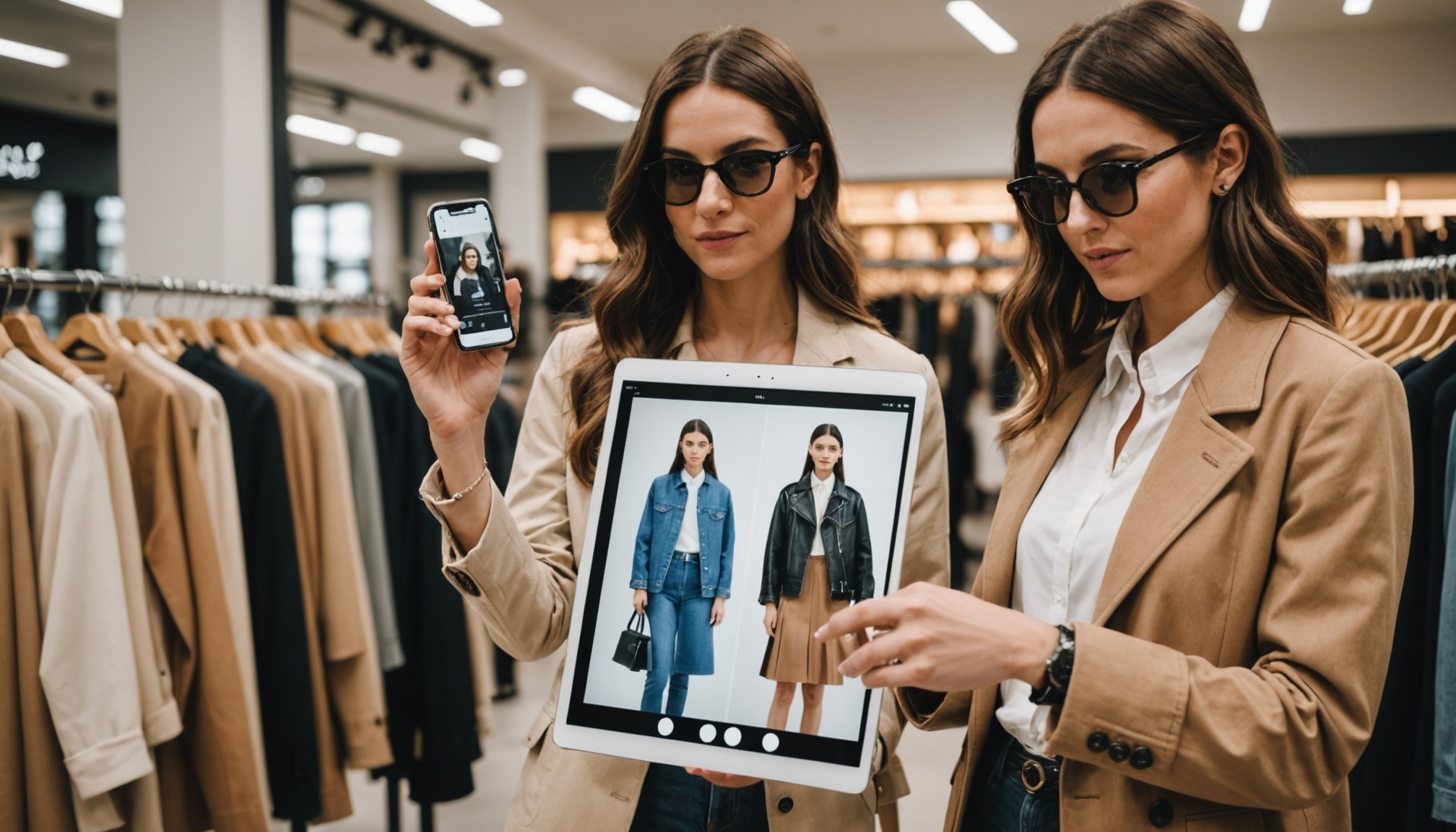Overview of Augmented Reality in E-commerce
Augmented Reality (AR) is revolutionising the retail and fashion industries, enabling consumers to interact with virtual elements in the physical world. This technology overlays digital information onto the real world, enhancing the shopping experience by allowing users to visualise products within their own environment. For UK fashion brands, AR offers a unique opportunity to engage customers more interactively and increase purchase confidence.
In the realm of e-commerce, AR is reshaping how businesses present their products. The application of AR technology allows customers to ‘try on’ clothes or accessories virtually, easing the traditional limitations of online shopping, where tactile experiences are absent. This interactive shopping method is gaining momentum, prompting many businesses to integrate AR solutions into their platforms.
In parallel : Revolutionizing University Management: Effective AI Solutions for UK Institutions to Enhance Operational Efficiency
The current AR landscape in e-commerce is robust, with continuous innovations improving user experiences. Major UK retailers are pioneering AR to offer virtual showrooms and fitting rooms, merging the digital and physical shopping experiences seamlessly. As these virtual experiences become more realistic and accessible, their adoption is expected to grow. By eliminating guesswork in online purchases, AR supports informed decision-making, ultimately enhancing customer satisfaction and boosting sales for e-commerce operations.
Case Studies of UK Fashion Brands Utilizing AR
Exploring the vibrant UK fashion scene, several brands have embraced Augmented Reality (AR) to revolutionize shopping experiences. These case studies demonstrate how AR can redefine customer engagement and propel sales growth.
Also to discover : Navigating Regulatory Waters: Key Compliance Strategies for UK Fintech Startups to Succeed
Brand A: Implementation and Success
Brand A swiftly integrated AR technologies to enhance customer experiences both online and in-store. By enabling customers to visualize products in real-time through virtual try-ons, they effectively reduced return rates, translating to higher customer satisfaction. The augmented fitting rooms became a standout feature, offering a seamless blend of physical and digital shopping. This led to an impressive 30% increase in online sales, showcasing the transformative potential of AR.
Brand B: Innovative AR Features
Brand B, known for its cutting-edge UK fashion innovations, leveraged AR by introducing a virtual personal stylist feature. Customers interactively mixed and matched outfits, allowing a personalized shopping journey that mirrors in-store advice. This innovative approach not only improved customer engagement but also cemented the brand’s position as a tech-forward entity in fashion. The immersive AR experience set new industry standards.
Brand C: AR Impact on Sales
With robust AR adoption, Brand C observed tangible results on their revenue streams. Interactive AR catalogs enabled shoppers to view textures and patterns in unprecedented detail, resulting in a remarkable 40% sales increase. This sharp rise in sales underlines the substantial impact AR can have on enhancing consumer decision-making and boosting brand loyalty in the competitive UK fashion market.
Benefits of Augmented Reality in Online Shopping
The integration of augmented reality (AR) in online shopping is revolutionising the user experience. By allowing consumers to interact virtually with products, AR enhances customer engagement in unprecedented ways. Imagine being able to see how a piece of furniture fits into your space or how clothes look on you without ever leaving your home. This level of interaction captivates customers, holding their attention longer and increasing the likelihood of a purchase.
Moreover, AR significantly aids the decision-making process for consumers. Traditional online shopping often leaves questions about size, colour, or compatibility. However, with AR, users can have a realistic preview of products, alleviating doubts and empowering informed purchasing decisions.
A notable benefit is the impact on return rates. By offering a thorough visualisation of products, AR reduces the uncertainty customers might feel, leading to more satisfactory purchases. This means fewer surprises upon delivery and consequently lower return rates. Retailers benefit as well by saving on costs associated with managing returns and enhancing customer satisfaction.
In summary, the benefits of AR are multifaceted, profoundly improving the online shopping experience by fostering deeper customer engagement, supporting better decisions, and lowering return occurrences through accurate product representation.
User Experience Enhancements Through AR
Augmented Reality (AR) technology is revolutionizing the user experience within fashion retail, offering innovative solutions that transform the traditional shopping model.
Immersive Shopping Environment
AR technology creates an interactive and immersive online shopping experience. Imagine walking through a virtual store, examining clothes with a 360-degree view, or trying on outfits without leaving your home. This technology allows users to visualize products more realistically, closing the gap between online and in-store shopping. This includes features like virtual fitting rooms and interactive 3D models, which can enhance buyer confidence and satisfaction.
Personalization and Customization
Fashion retailers can leverage AR to offer tailored shopping experiences, aligning with individual user preferences. By analyzing past purchases and browsing habits, AR tools suggest items that fit personal styles, ensuring a more enjoyable and relevant shopping experience. This level of personalization not only delights customers but can potentially increase brand loyalty.
Accessibility and Inclusion
AR promises to make fashion retail more inclusive. By offering features like adjustable text sizes and voice-guided navigation, AR tools can ensure diverse consumer groups benefit from this technology. This means providing equal shopping opportunities regardless of physical limitations, thereby broadening the user experience landscape. Emphasizing accessibility ensures that everyone can enjoy the benefits of advanced retail technologies.
Statistics on AR’s Impact on Sales
The use of Augmented Reality (AR) has had a noteworthy impact on consumer purchasing behaviour, particularly in e-commerce. According to recent data, more than 30% of consumers are inclined to make a purchase after using AR tools. This shows a significant shift in consumer habits, as AR provides a more interactive and engaging shopping experience.
A comparative analysis of sales figures before and after the integration of AR technologies reveals a 40% increase in conversion rates. This uplift exemplifies the power of AR in enhancing product visualization, leading to a more informed and confident purchase decision.
Customer retention rates have also seen an uptick with the implementation of AR experiences. Companies that leverage AR technology reported a retention rate increase of around 25%. The novelty and practicality of AR applications, such as virtual try-ons and 3D visualizations, contribute to an enriched customer journey, encouraging repeat purchases and brand loyalty.
In summary, AR not only boosts immediate sales conversion but also plays a crucial role in fostering long-term customer relationships, reinforcing its growing significance in the digital marketplace. Each statistic highlights AR’s crucial role in reshaping the future of e-commerce.
Future Trends of AR in Fashion E-commerce
The fashion industry has long been a trendsetter, and the integration of AR technology is no exception. As we look towards the future, it’s exciting to consider the evolving impact of AR in the digital shopping experience.
Predictions for AR Evolution
In forecasting the evolution of AR, we anticipate advancements in real-time virtual try-ons, allowing consumers to visualize clothing and accessories with ever-increasing accuracy. The precision of AR technology is expected to improve significantly, enabling better fit predictions and reducing return rates.
Integration of AI with AR
A potential game-changer lies in the synergy between AI and AR. By combining AI’s data analytics with AR technology, consumers could receive highly personalized shopping recommendations based on their past preferences. This integration promises an enhanced, tailored shopping experience that caters to individual tastes and styles with precision.
Expansion into Other Market Segments
Beyond fashion e-commerce, AR technology is poised to expand into various other market sectors. Industries such as home decor and cosmetics can benefit significantly from AR’s application, providing customers with immersive product experiences. This expansion is driven by the increasing versatility and accessibility of AR tools, bridging the gap between traditional and digital shopping realms.
The fashion industry’s continued embrace of AR indicates a promising future, with innovative solutions enhancing both customer engagement and business opportunities.






